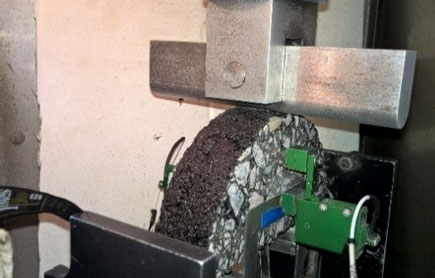along the axis of a 6-inch pavement cylinder to measure susceptibility to
cracking at low temperatures.
Photo: MnDOT
In a new study, U of M researchers have proposed four tests to evaluate the susceptibility of asphalt materials to cracking. The tests could help with materials selection testing, quality control, and forensic examination of samples from existing asphalt pavements.
“These test methods produce repeatable, consistent results, are simple to perform, and differentiate between mixtures,” says Mihai Marasteanu, a professor with the Department of Civil, Environmental, and Geo- Engineering. “They could provide critical information on the evolution of pavement performance since they can be used for forensic analyses.”
The Minnesota Department of Transportation (MnDOT), in partnership with the National Center for Asphalt Technology and four other state transportation agencies, is part of a pooled-fund study to develop mixture performance testing focused on cracking. The group wanted to better understand the viability of testing methods that were not included in other related studies.
“This was a knowledge-building, data-gathering study that will help fill out our materials library database to correlate test results of asphalt materials to field performance,” says David Van Deusen, research operations engineer with MnDOT’s Office of Materials and Road Research.
The tests were conducted on asphalt mixtures sampled from test sections of the MnROAD pavement test facility. Researchers pulled cores from eight existing pavement sections and ran three tests on the eight asphalt mixtures and one test on the five asphalt binders used in the pavement mixtures. They found that all four tests were viable options, that sample performance was highly dependent on temperature, and that the eight mixtures tested may perform similarly.
MnDOT will share test results with its research partners and include them in the overall examinations of the MnROAD test cells. Researchers recommend repeating these tests with the pavement cells periodically to correlate field conditions and tested mixture performance over time. In addition, MnDOT will consider some of these testing methods and findings for its continuing effort to develop a performance-based balanced mix design approach for asphalt pavement.



